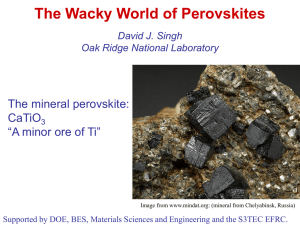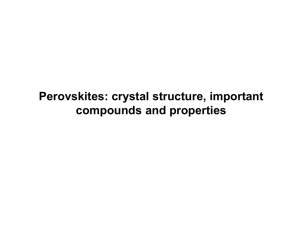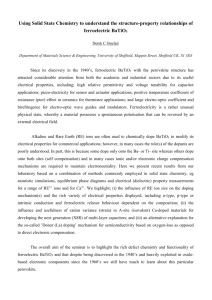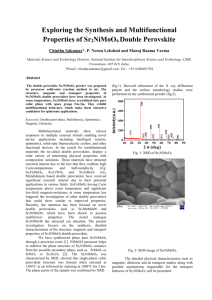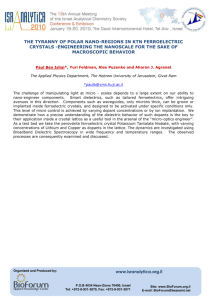Applications of Structure Optimization and Forces in the LAPW
advertisement
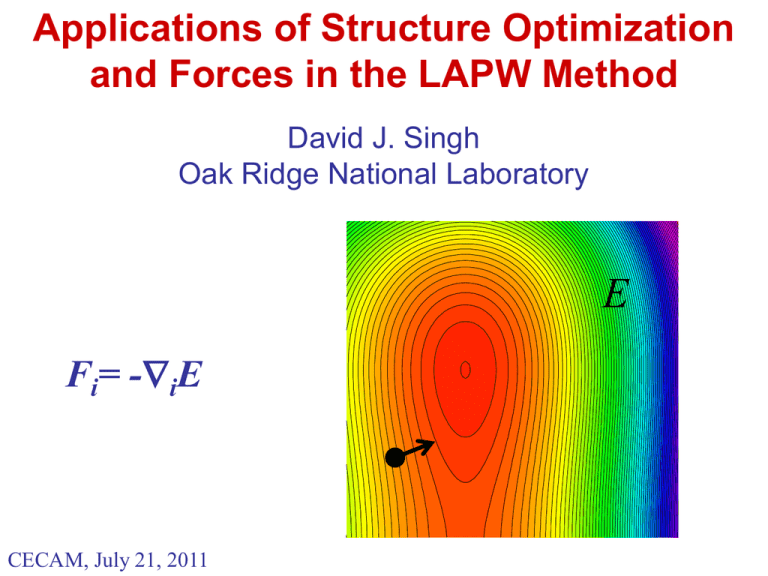
Applications of Structure Optimization
and Forces in the LAPW Method
David J. Singh
Oak Ridge National Laboratory
E
Fi= -iE
CECAM, July 21, 2011
Exploring Complex Energy Surfaces
Suppose we want to know about h(x,y) by making measurements on a set
of points xi,yi i=1…n
Measure h at each point
n pieces of
information.
Measure F=-h
2n pieces of
information.
Measure both
3n pieces of
information.
If we want to know F at
a given location we
need 3 measurements
of h (finite difference)
Medical Imaging
Materials discovery to commercial products in less than seven
years
PZT
2000
Piezocrystal:
2004
What are Ferroelectrics?
+Vf
Q
0
Note analogy with Ferromagnets
How Does PZT Work?
Cubic Perovskite Structure
Tetragonal FE
TO() unstable
phonon
(Ferroelectric)
Ground state can be tetragonal,
orthorhombic, rhombohedral or monoclinic.
Jaffe, Cook, and Jaffe, (1971).
Piezoelectric Ceramics
PZT near the
morphotropic
phase boundary
is the basis of
current devices
Forces in Periodic Solids
• N atoms in the unit cell:
• E(r1,r2, … ,rN)
1 piece of information
• Fi(r1,r2, … ,rN) = -iE(r1,r2, … ,rN) 3N-3 pieces of information
n.b. acoustic sum rule requires Fi = 0
Calculation of forces provides much more information than
calculation of the energy alone, especially as one goes to more and
more complex materials
enabling for many applications, e.g. determination of structures.
Example: Zone Center Phonons
Harmonic approximation: N atoms
r = {r1,r2, … ,rN} (3N component vector); r0 is the equilibrium.
E(r) = E0 + 1/2(r-r0)Tk(r-r0)
F(r) = K(r-r0)
Can readily determine K and r0 with N+1 calculations around the
expected position of r0 (one less if the acoustic sum rule is used)
equilibrium position and phonon frequencies and polarization vectors.
Doing this with energies alone would require at least (3N+1)(3N+2)/2
calculations (k is symmetric).
Molecular Dynamics
• Molecular dynamics using force from DFT
rather than empirical potentials.
• Advantage: the interesting regions often
are places where empirical potentials are
most in doubt, e.g. bond breaking …
• First principles MD is efficient if one can
Snapshot of a first-principles molecular
dynamics simulation of water molecules
solve the Kohn-Sham equations quickly
reacting on the 110 surface of titanium
starting from the solution at the prior step oxide. (P.R.C. Kent).
true for planewaves (CP).
• Not very efficient in methods like LAPW Not common with LAPW
where the complex basis depends on the
but this could change.
atom positions.
Thermal Conductivity
Heat transport in solids is a central problem in
technology:
• Thermal Barrier Coatings.
• Electronics.
• Heat Exchangers.
• Cookware.
• Nuclear Reactor Fuel.
• Thermoelectrics.
Often calculated with classical molecular
dynamics, but not with first principles.
Turbine blade with coating
(wikipedia)
Thermal Conductivity (con’t)
Kubo Formula:
R. Kubo, M. Yokota and S. Nakajima, J. Phys. Soc. Jpn. 12, 1203 (1957).
q(t) is the heat current
“power”
volume
distance
Problem:
This requires Fij not just Fi.
Structure Optimization
• Key to problems like ferroelectricity where
ground state structures play the central role.
• Well developed area of mathematics: tractable
algorithms rely on forces.
Some Algorithms:
Steepest Descent:
• At each step, proceed in the direction of the
gradient to the minimum.
• Each direction is orthogonal to the previous
one very slow convergence.
• Can modify by not going all the way to the
minimum on each step, but using e.g. some
mixing parameter.
wikipedia: conjugate
gradient method
(shows problem with
steepest descent)
Structure Optimization (con’t)
Damped Dynamics (simulated annealing):
• Molecular dynamics algorithm but with a
portion of the kinetic energy removed at
each step.
• Can overcome local minima on complex
energy surfaces.
Conjugate Gradient:
• Very fast convergence for nearly harmonic
surfaces.
• Like steepest descent, but line
minimizations are along “conjugate
directions” rather than the direction of the
force.
wikipedia: conjugate
gradient method
Wikipedia: Conjugate Gradient Method
These are not the steepest descent
directions after the first iteration.
Avoid sawtooth path down a valley
Caution
• Force convergence and structure convergence are not the same thing.
• There can be soft degrees of freedom even in stiff materials
you can get small forces and be far from the true structure.
Example: Ferroelectrics
where very different
structures are close in energy.
Cubic
Rhombohedral
Tetragonal
References for Forces
• J.M. Soler and A.R. Williams, Phys. Rev. B 40, 1560 (1989).
• J.M. Soler and A.R. Williams, Phys. Rev. B 42, 9728 (1990).
• R.C. Yu, D. Singh and H. Krakauer, Phys. Rev. B 43, 6411 (1991).
PART 2
Ferroelectricity in Perovskites
How much of a good thing is enough?
Co-workers:
Valentino Cooper
Shigeyuki Takagi
Alaska Subedi
D.I. Bilc
S.V. Halilov
M. Fornari
The Size of an Atom
Inter-atomic distance,
d = rA + rB
Crystallographic data
“defines” the “sizes” of
atoms.
d
INSTABILITIES OF PEROVSKITES
Chemical Understanding:
• Main interactions are (1) Coulomb (ionic) and (2) Closed shell
repulsions.
Competition of bond lengths
drives most perovskite
instabilities.
Tolerance Factor:
t = (rA+rO)/2(rB+rO)
(a) t>1 (B ion [Ti] is too small)
B site off-centering and
ferroelectricity (BaTiO3, KNbO3)
PbTiO3
(b) t<1 (A ion [Pb] is too small)
Rotation of octahedra, e.g.
CaTiO3, GdFeO3, LaMnO3… (the
great majority of perovskites).
Role of Pb on the Perovskite A-Site
•
Pb allows t<1 perovskites to be ferroelectric instead of
Pnma or similar.
Electronic Structure:
Pb
O
R.E. Cohen, 1992
Zr/Ti
Cross-gap hybridization:
6p
3d/4d
• Increases Z*
• Softens interactions
EF
• Increases polarizability
• Favors Ferroelectricity
2p
6s
Are there Pb-free materials
that are as good as or
even better than the Pbbased materials, e.g. PZT?
BiFeO3:
• A very high polarization material
based on structure (Tomashpol’skii,
1967), but not usable due to
conductivity.
Answer was long thought to
be no…
… but results in the last
decade for materials such as
BiFeO3 suggest a closer
look.
Lebeugle et al., APL 2007, room temp.
The Perovskite Structure
Pauling Rules - JACS 51, 1010 (1929).
1. “the cation-anion distance being
determined by the radius sum and
the coordination number of the
cation by the radius ratio”
2. “charge of each anion tends to
compensate the strength of the
electrostatic valence bonds reaching
it”
3. “shared edges and particularly
shared faces … decreases stability;
this effect is large for cations with
large valence …”
Problem:
from www.crystalmaker.co.uk
• Bi3+ vs. Pb2+ implies lower average B-site charge.
• Bi3+ has c.r.~1.3 Å << Pb2+ (1.63 Å).
Bi perovskites are often difficult to make.
ROTATIONAL MODE
• Distortion around A
(A-O bond lengths)
• Bends B-O-B bonds
but only bond
lengths in second
order. (n.b. breathing
mode is usually stiff).
• Driven by pressure
and/or tolerance
factor if octahedra
are stiff.
• Alternate is A-site
off-centering (Pb).
INSTABILITIES OF PEROVSKITES
Single sub-lattice off-centering (LDA):
Expt. Volume:
6% Expansion:
INSTABILITIES OF PEROVSKITES
LDA calculations constrained to rhombohedral ferroelectric
Displacements in Bohr along x direction (0.529 3 Ang. disp.)
Cooperative A-site and B-site displacements
characterize good perovskite ferroelectrics
also Grinberg & Rappe (2004) showing TC in relation to cooperativity.
Strain Coupling
Allowing only ferroelectric states & at the LDA lattice parameter:
t ~ 0.9
Why are these
so different
• Note rhombohedral ferroelectric phase is
very much more stable than tetragonal.
• Note large ferroelectric energy.
• Also note the large c/a of the tetragonal.
R-FE vs. T-FE LDA ENERGETICS
•A site ion is 12-fold coordinated (very isotropic).
•B site ion is 6-fold (octahedral).
B-site responds to A-site
off-centering, and the B-site
off-centering favors the
rhombohedral state. This is
why we have MPB’s in Asite driven materials.
Halilov, Fornari, Singh, PRB 67, 174107 (2004)
Ghita, Fornari, Singh, Halilov, PRB 72, 054114 (2005)
What If …
… we could eliminate the tilt instability from
arbitrary t<1 perovskites?
According to first principles ferroelectricity would
result.
• This is found universally for low t.
• It consists of A-site off-centering.
CdTiO3 and Alloys with PbTiO3
Density functional calculations for CdTiO3 (small tolerance factor,
possibly interesting chemistry)
• CdTiO3 has antiferroelectric ground
state.
• If forced ferroelectric it has a large
tetragonal strain in the tetragonal
FE state, and high energy scale.
“Ferroelectric CdTiO3”
• Supercells for 50-50 CdTiO3PbTiO3 are borderline ferroelectric
and tetragonal and have a large
c/a~1.08 (higher than PbTiO3).
S.V. Halilov, M. Fornari and D.J. Singh, Appl. Phys. Lett. 81, 3443 (2002).
Experimental Confirmation
This was the second example of an alloy with PbTiO3 that increases c/a.
Volume Dependence of Modes (50-50 PZT)
•Fornari and Singh, 2000.
Ferroelectric Mode ()
•
•
•
•
Rotational Mode (R)
Volume dependence of FE and Rotational Instabilities is large and opposite.
Implies co-existence in disordered alloys due to local stress fields.
Tilts are active in PZT even at the MPB.
Generally in low tolerance factor perovskites, tilts and ferroelectricity
compete with tilts “winning” unless there are stereochemically active Asite ions.
Phonons In Ferroelectric Perovskites
First Principles Calculations
of Ghosez et al. (1999):
• note R point instabilities in
PZ and PT but not BT.
• Note different coherence
lengths for zone center
and zone boundary
instabilities.
ROTATIONAL MODE
Can we use disorder to
exploit the difference in
coherence length between
rotational and ferroelectric
instabilities?
Hypothetical Perovskite: K0.5Li0.5NbO3
• K and Li have very different sizes (1.8Å vs. 1.1Å).
• What if we make a perovskite alloying K and Li on the A-site?
• Strong off-centering of Li (A-site driven ferroelectric) – Tilt does not happen.
D.I. Bilc and D.J. Singh, PRL 96, 147602 (2006).
Single ion off-centering
•Reason for tetragonal state is the very large displacement of Li.
1) Tc is maintained high under Ca alloying
even though the average tolerance factor
is strongly decreasing.
2) The system becomes much more
tetragonal as Ca is added.
Ba1-xCaxTiO3
A-Site Alloys with Bi
• Bi0.5Sr0.5Zn0.5Nb0.5O3 was reported in perovskite structure by
Kosyachenko et al. [Neorg. Mater. 18, 1352 (1982)] and
evidence pointing towards ferroelectricity was found.
• Bi0.5Pb0.5Zn0.5Nb0.5O3 would be the 50-50 solid solution of PZN
with hypothetical BiZn2/3Nb1/3O3.
• (Na,Bi)TiO3 is a known material that has been investigated alone
and in alloys with PbTiO3 and KNbO3.
• Bi(Zn0.5Ti0.5)O3 was shown to be a super tetragonal ferroelectric
with very high polarization by Suchomel and Davies [APL 86,
262905 (2005)].
(Bi,Pb)2ZnNbO6 Supercells
NaCl (111) layers
5+
A-type (100) layers • Charge difference of Nb and
Zn2+ is 3 favors chemical
ordering.
• PbZn1/3Nb2/3O3 (PMN) has a
two sub-lattice (double
perovskite based) structure
should be stronger for Zn:Nb
ratio at 1:1.
Pb
Bi
C-type [001] chains
Clusters
• Done at LDA lattice parameter
somewhat compressed [3.99
Å for Pb and 3.97 Å for Sr]
• LDA calculations for 40-atom
double perovskite supercells
with various Bi/Pb orderings
and rocksalt Bi/Sr ordering.
BiPbZnNbO6
Relaxed G-type cell at LDA lattice parameter (3.99 Å), pseudo-cubic
Cation off-centerings
in O cages
• Large off-centerings of Bi, but also
substantial for other ions, including Nb.
• Off-centering is along [111].
• Similar results for other three supercells.
S. Takagi, A. Subedi, D.J. Singh and V.R. Cooper, Phys. Rev. B 81, 134106 (2010)
BiPbZnNbO6
G-type supercell as a function of pseudo-cubic lattice parameter:
• Increasing off-centering with increasing volume, as usual (LDA
may underestimate).
• Substantial off-centerings of Nb.
BiPbZnNbO6
• G-type cell was relaxed as a function of tetragonal strain
• Minimum energy was at a c/a ratio of ~1.015, but this appears to be due to
tilts, not ferroelectricity (supercell artifact)
Off-centerings for
imposed c/a=1.0606
Note that offcentering does not
switch to [001]
even with large
imposed strain.
Polarization: BiSrZnNbO6 and the Role of Pb
BiSrZnNbO6
• Known compound that readily forms in perovskite
structure.
• Average A-site charge is +2.5 Av. B-site is +3.5
(better for stability of perovskite).
• Polarization is comparable to pure Bi compounds
even though there is only 50% Bi.
• Reason is large Bi displacement & Nb off-centering.
BiSrZnNbO6 – Bi2ZnTiO6 Solid Solution
• Bi(Zn,Ti)O3 has a very large polarization ~150 µC/cm2 but is
essentially non-switchable due to super-tetragonality, c/a ~ 1.2
(Suchomel, 2006).
• Can we produce a useful MPB by alloying – key may be to alloy
with a strongly R material that produces an MPB far from the
BZT end so that it can be switchable.
• We did supercell calculations for the pseudo-binary solid
solution with BiSrZnNbO6.
• We used 40 and 80 atom cells with Zn and (Ti,Nb) on separate
sublattices (i.e. double perovskite).
BiSrZnNbO6 – Bi2ZnTiO6 Solid Solution
Average cation off-centerings in supercells:
Proposed Phase Diagram
Direction of P relative to 111 and 100:
• We find a region with a possible MPB and high polarization,
although the tetragonality on the T side is still very high.
Summary and Conclusions
• It is possible to obtain ferroelectricity in t<1 and t=1
perovskites without relying on Pb or Pb analogues.
• Disorder on the A-site can also be used with Bi.
• Can obtain high polarization ferroelectricity in
materials like (Bi,Sr)(Zn,Nb)O3
• Provides a more opportunities for Pb-free materials
than pure Bi compounds alone.
• Co-operativity between A-site and B-site off-centerings
provides opportunities for new MPB systems.
